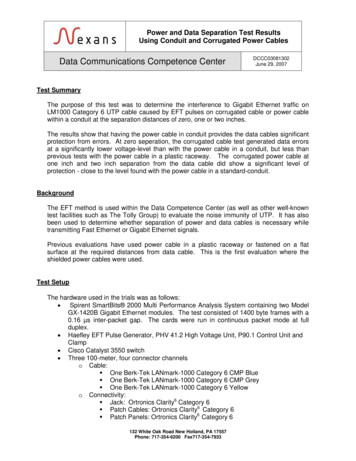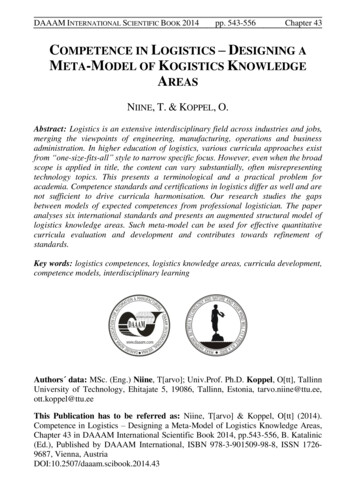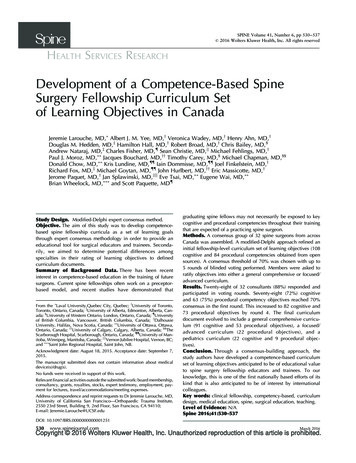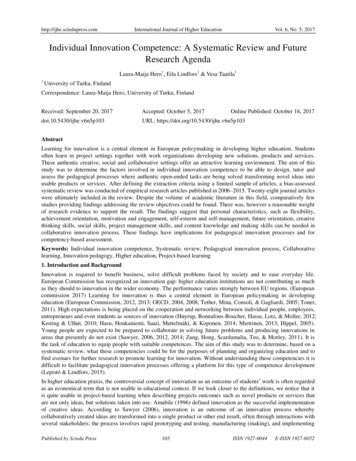
Transcription
Power and Data Separation Test ResultsUsing Conduit and Corrugated Power CablesData Communications Competence CenterDCCC03081302June 29, 2007Test SummaryThe purpose of this test was to determine the interference to Gigabit Ethernet traffic onLM1000 Category 6 UTP cable caused by EFT pulses on corrugated cable or power cablewithin a conduit at the separation distances of zero, one or two inches.The results show that having the power cable in conduit provides the data cables significantprotection from errors. At zero seperation, the corrugated cable test generated data errorsat a significantly lower voltage-level than with the power cable in a conduit, but less thanprevious tests with the power cable in a plastic raceway. The corrugated power cable atone inch and two inch separation from the data cable did show a significant level ofprotection - close to the level found with the power cable in a standard-conduit.BackgroundThe EFT method is used within the Data Competence Center (as well as other well-knowntest facilities such as The Tolly Group) to evaluate the noise immunity of UTP. It has alsobeen used to determine whether separation of power and data cables is necessary whiletransmitting Fast Ethernet or Gigabit Ethernet signals.Previous evaluations have used power cable in a plastic raceway or fastened on a flatsurface at the required distances from data cable. This is the first evaluation where theshielded power cables were used.Test SetupThe hardware used in the trials was as follows: Spirent SmartBits 2000 Multi Performance Analysis System containing two ModelGX-1420B Gigabit Ethernet modules. The test consisted of 1400 byte frames with a0.16 µs inter-packet gap. The cards were run in continuous packet mode at fullduplex. Haefley EFT Pulse Generator, PHV 41.2 High Voltage Unit, P90.1 Control Unit andClamp Cisco Catalyst 3550 switch Three 100-meter, four connector channelso Cable: One Berk-Tek LANmark-1000 Category 6 CMP Blue One Berk-Tek LANmark-1000 Category 6 CMP Grey One Berk-Tek LANmark-1000 Category 6 Yellowo Connectivity: Jack: Ortronics Clarity6 Category 6 Patch Cables: Ortronics Clarity6 Category 6 Patch Panels: Ortronics Clarity6 Category 6132 White Oak Road New Holland, PA 17557Phone: 717-354-6200 Fax717-354-7933
Conduit and Corrugated Power Cable Data Separation Test DCCC03081302June 29, 200790 meters of ½ inch EMT conduit with 3 #12 THHN conductors and a 20 ampere,120 volt duplex receptacle at each end.90 meters of 12/2 MC cable with 20 ampere, 120 volt duplex receptacle at each end.The EFT test is used to evaluate the effect of a power cable on a nearby data cable.Using the Haefley unit, electrical fast transient (EFT) pulses are generated with a normalcurrent onto the power cable. Gigabit Ethernet data packets are transmitted along the LANcable, which is located a controlled distance from the power cable. The number of datapacket errors is monitored at each EFT pulse voltage.Figure 1: EFT Test Setup with SmartBits Data GenerationFigure 2: Haefley Generator and Cisco SwitchFigure 3: Haefley Generator and heat sink.Each LM1000 cable was installed one at a time on the shelf structure first at zeroseparation, then again at one and two inch spacing from the data cable.The Haefley EFT Pulse Generator was connected to either the corrugated power cable orthe power cable within the conduit with a heater connected to the other end as a sink. Thevoltage level of the EFT pulse was constant for each 300-million packet test, with thevoltage increasing in each consecutive test.Page 2 of 10
Conduit and Corrugated Power Cable Data Separation TestDCCC03081302June 29, 2007A SmartBits fiber card sent and received 1400 octet packets with 0.16 microsecond interpacket gap to the Cisco switch through a MMF link. The data traffic passed through theCisco switch onto the test cable channel, back to the Cisco switch and then onto fiber cablereturning to a second Smartbits card.Errors were seen as dropped packets, since the Cisco switch treats CRC errors by droppingthe packets.Test ResultsCorrugated Cable ResultsCorrugated Power Cable EFT TestYellow ltageyellow-0 inchyellow-1 inch18502100yellow-2 inchFigure 4: Results of all voltages for the yellow data cable with the corrugated power cable.Page 3 of 10
Conduit and Corrugated Power Cable Data Separation TestDCCC03081302June 29, 2007Corrugated Power Cable EFT TestGrey 50Voltagegrey-0 inchgrey-1 inch210027003350grey-2 inchFigure 5: Results of all voltages for the grey data cable with the corrugated power cable.Corrugated Power Cable EFT TestBlue ltageblue-0blue-1blue-2Figure 6: Results of all voltages for the blue data cable with the corrugated power cable.In Figures 4-6, the results are graphed at each of the three distances from the power cable.Observations from these charts: At zero separation, errors are generated at 350-volts. The LM1000 cable waspreviously tested with power cable at zero separation in a plastic raceway anddemonstrated errors beginning at 500 volts. This indicates that zero separationaffects the data cable more than the added shielding helps it.Page 4 of 10
Conduit and Corrugated Power Cable Data Separation TestDCCC03081302June 29, 2007 For two of the cables (grey and yellow) tested, as the distance between thecorrugated power cable and the data cable increased to one and two inches, thethreshold voltage increased significantly. The blue cable showed a significant increase in the voltage where errors are seenwhen the distance is increased from zero to one inch, but when the distance wasincreased again, there was very little increase in the voltage where errors were seen.This anomaly may be due to grounding issues or the placement of the cable.Power Cable in a Conduit ResultsPower Cable in a Conduit EFT Test ResultsYellow ltageyellow-0 inchyellow-1 inch22502550yellow-2 inchFigure 7: Results of all voltages for the yellow data cable with the power cable in solid conduit.Page 5 of 10
Conduit and Corrugated Power Cable Data Separation TestDCCC03081302June 29, 2007Power Cable in a Conduit EFT Test ResultsBlue eblue-0 inch2000blue-1 inchblue-2 inchFigure 8: Results of all voltages for the blue data cable with the power cable in solid conduit.Power Cable in a Conduit EFT Test ResultsGrey 0 inchgrey-1 inch212631grey-2 inchFigure 9: Results of all voltages for the yellow data cable with the power cable in solid conduit.In Figures 7-9, each individual cable has results shown at the zero, one and two-inchseparations.Observations from the chart: The voltage where errors start to occur at zero separation between the conduit andthe data cable is in the 1400 to 2250 volt range.Page 6 of 10
Conduit and Corrugated Power Cable Data Separation TestDCCC03081302June 29, 2007 As was observed in the corrugated power cable tests, the increase of distancebetween the conduit and the data cable correlates to a significant increase in thevoltage where errors occur. The grey cable shows an anomaly where the zero separation between the conduitand the data cable shows the occurrences of errors beginning at a higher voltagethan the one-inch separation. This behavior is currently under investigation. The yellow cable shows a significant difference in voltages where errors began atzero and one inch separation. The level where the errors increase to above 3000errors for these same separations is at the 2550 voltage level.Error LevelsIn Table 1, the voltages are listed for each LM1000 cable and each separation distance.The averages of the cables clearly show the advantage of power cable in a conduit for zeroseparation. As the separation is increased to one and two inches, the advantage remains toa lesser degree.Voltage of First 0-100128320083Table 1: Voltages of the first occurrences of errorsTo view clearly the point at which errors occur using the two methods of shielding, thevoltages of the first occurrences of errors is correlated to the separation. Figures 10 and 11show the relationship.First Errors with ConduitFirst Errors with g1000First Error VoltageFirst Error 0001Distance to Power in Inches02Figure 10: Voltage of Conduit First Errors12Distance to Power in InchesFigure 11: Voltages of Corrugated First ErrorsPage 7 of 10
Conduit and Corrugated Power Cable Data Separation TestJune 29, 2007DCCC03081302Figure 12 shows the voltage differences between the conduit results and corrugated results.The advantage of conduit at zero inch averages to 1250 volts, while the difference drops to200 for one-inch and 50 for two-inches.Reduction of ErrorsReduction of Errors with 10Conduit over CorrigatedConduit over 001Voltage DifferenceVoltage 50020Distance to Power in Inches12Distance to Power in InchesFigure 12: Advantage at First Occurrence of Errors-6Figure 13: Advantage at 10 ErrorsIn Figure 12, the advantage of power cable in a conduit is clearly seen at zero separation.The one and two inches average to a slight positive advantage. Figure 13 gives thereduction of errors at 10-6 errors, which supports the averages found in Figure 12 at aslightly higher error rate.Individual Cable AnalysisCorrugated Power Cable EFT Test 001450170028503100VoltageFigure 14: Results of all voltages for corrugated power cable up to 1000 errors.By looking at the test results in Figure 14, it is clear that increasing the distance from zero toone and then to two inches, significantly impacts the voltage where errors occur for both thegrey and yellow cables. Also, even though the first increase in distance acts similarly, thesecond increase only slightly raised the voltage of the first errors.In the blue and grey cables with two-inch separation, it is observed that there is a dip in thenumber of errors as the voltage levels are increased. This is also seen in results from theconduit tests.Page 8 of 10
Conduit and Corrugated Power Cable Data Separation TestDCCC03081302June 29, 2007Power Cable in a Conduit EFT Test 5020002250255028003400VoltageFigure 15: Results of all voltages for conduit power cable up to 1000 errors.Figure 15 illustrates that the blue cable has regular increases in the voltages of the firsterrors, unlike the results with corrugated cable. This figure also shows that the grey cable atone-inch has lower voltages of first errors than the grey cable at zero separation.ConclusionsThe conclusion that can be drawn from these tests is that the corrugated power cable withEFT pulse spikes at zero separation causes the highest level of errors to nearby datacables. At the one and two-inch levels, the corrugated power cable provides slightly lessprotection than the power cable in a conduit.There are several anomalies in the results from these trials. It is possible that there weregrounding issues, which may have taken part. For the majority of the testing, the increase indistance significantly improved the threshold voltage where errors were detected.Page 9 of 10
Conduit and Corrugated Power Cable Data Separation ERUTPDCCC03081302June 29, 2007Table 1: Definitions of AcronymsDescriptionCategory 5 cableCategory 6 cableCategory 6 enhanced cableCyclic Redundancy CheckElectrical Fast TransientHeat, Ventilation and Air ConditioningInstitute of Electrical and Electronics EngineersLocal Area NetworkNetwork Interface CardPacket (Frame) Error RateUnshielded Twisted PairData Communications Competence CenterNexans’ Data Communications Competence Center, located at the BerkTek Headquarters in New Holland, Pennsylvania, focuses on advancedproduct design, applications and materials development for networkingand data communication cabling solutions. The Advanced Design andApplications team uses state-of-the-art, proprietary testing and modelingtools to translate emerging network requirements into new cablingsolutions. The Advanced Materials Development and AdvancedManufacturing Processes teams utilize sophisticated analyticalcapabilities that facilitate the design of superior materials and processes.The Standardization and Technology group analyzes leading edge andemerging technologies and coordinates data communicationstandardization efforts to continuously refine Nexans’ TechnologyRoadmap. An international team of experts in the fields of cable,connectors, materials, networking, standards, communications andtesting supports the competence center. The competence centerlaboratories are a part of an extensive global R&D network that includeseight competence centers, four application centers and two researchcenters dedicated to advanced technologies and materials research.Page 10 of 10
Power and Data Separation Test Results Using Conduit and Corrugated Power Cables Data Communications Competence Center DCCC03081302 June 29, 2007 132 White Oak Road New Holland, PA 17557 Phone: 717-354-6200 Fax717-354-7933 Test Summary The purpose of this test was to determine the interference to Gigabit Ethernet traffic on LM1000 Category 6 UTP cable caused by











